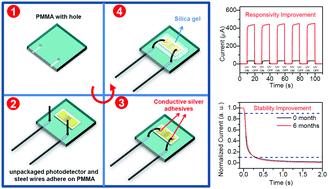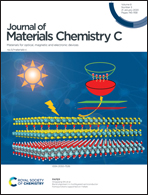Responsivity improvement of a packaged ZnMgO solar blind ultraviolet photodetector via a sealing treatment of silica gel†
Abstract
Packaging is one of the most important procedures of the fabrication of photoelectric devices, such as ZnMgO solar blind ultraviolet (UV) photodetectors. The roles of packaging are: electrically interconnecting an unpackaged photodetector and pin as well as fixing it, and protecting the unpackaged photodetector from external dirt, humidity and atmosphere. Nowadays, the research on the ZnMgO solar-blind UV photodetectors has well developed. However, the research on the packaging of these photodetectors are rare. In this study, we have focused on the packaging of ZnMgO solar blind UV photodetectors. After a direct wire bonding method between steel wires and unpackaged photodetectors by conductive silver adhesives and a sealing treatment by silica gel, the ZnMgO photodetector was packaged, and the responsivity of the device was found to increase after the packaging. A −3 dB cutoff wavelength of 295 nm and a responsivity of 191 A W−1 were achieved under a bias of 10 V. The 90–10% decay time of the device was 280 ms, and the dark current of the device was 115 pA under a bias of 10 V. Moreover, the stability of the ZnMgO-based solar blind photodetector obviously improved due to the well-sealed packaged structure.



 Please wait while we load your content...
Please wait while we load your content...